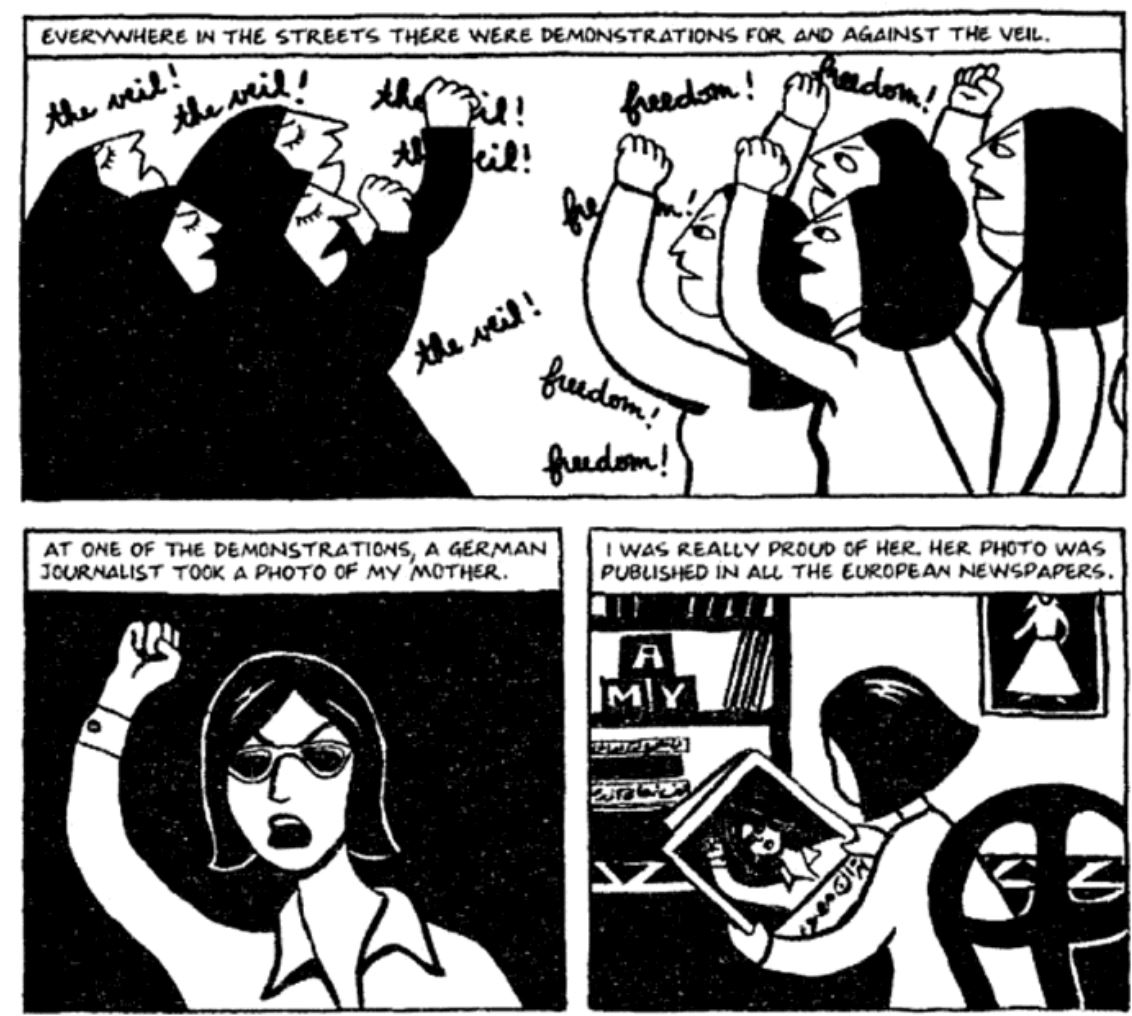
By Marjane Satrapi, translated by Anjali Singh (Jonathan Cape/Vintage)
ISBN: 978-0-22406-440-8 (v1 HB) 978-0-22407-440-7 (v2 HB) 978-0-09952-399-4 (TPB)
With Marjane Satrapi’s new book – Woman, Life, Freedom – due for publication next week, let’s take another look at the landmark cartoon biography that started her impressive career as a political commentator, activist and feminist icon before her appraisal of the changes (and not) of the current Iranian Revolution make her a target all over again…
No comics celebration/retrospective of women in our art form could be complete without acknowledging Marjane Satrapi’s astounding breakout memoirs, so let’s revisit both her Persepolis books (also available in a complete edition released to coincide with the animated movie adaptation) before you are inescapably compelled to graduate to later forays like The Sigh, Monsters are Afraid of the Moon, Chicken With Plums or Embroideries.
The imagery of a child, their unrefined stylings and shaded remembrances all possess captivating power to enthral adults. As the author grew up during the Fundamentalist revolution that toppled the Shah of Iran and replaced him with an Islamic theocracy, her recollections and comic interpretations of that time are particularly powerful, moving and – regrettably – more relevant than ever two decades later…
Originally released in France by L’Association between 2000 and 2003 as a quartet of annual volumes of cartoon reminiscence, in Persepolis – The Story of a Childhood Satrapi curated and related key incidents from her life with starkly primitivistic and forthright drawings depicting a sharp, unmoderated voice channelling perceptions of the young girl she was. That simple reportage owes as much to Anne Frank’s diary as Art Spiegelman’s Maus as Satrapi shares incidents that shaped her life and identity as a free-thinking “female” in a society increasingly frowning upon that sort of thing…
By focusing on content of the message and decrying or at best ignoring the technical skill and craft of the medium that conveys it, Persepolis became the kind of graphic novel casual and intellectual readers loved – as did kids everywhere but Chicago in 2013. Here the Public Schools CEO – apparently immune to irony – ruled years after translated publication that the books contained “graphic language and images that are not appropriate for general use” and banned them from “her” classrooms and high schools: a decision quickly reversed when students organised demonstrations and massed at public libraries to read them anyway…
However, graphic narrative is as much an art form of craft and thought as it is the dustbin of sophomoric genre stereotypes that many critics relegate it to. Satrapi created a work that is powerful and engaging, but in a sorry twist of reality, it is one that comics fans, and not the general public, still have to be convinced to read.

In the sequel Persepolis – The Story of a Return, the child-centric reminiscences of a girl whose childhood spanned the fall of the Shah and the rise of Iran’s Fundamentalist theocracy, Satrapi delved deeper into her personal history, concentrating more fully on the little girl becoming an autonomous, independent woman.
This idiosyncratic maturation unfortunately somewhat diminishes the power of pure, unvarnished observation that is such a devastating lens into the political iniquities moulding her life, but does transform the author into a fully concretised person, as many experiences more closely mirror those of an audience which hasn’t grown up under a cloud of physical, political, spiritual and sexual oppression.
The story recommences in 1984 where 15-year old Marjane is sent to Vienna to (ostensibly) pursue an education. In distressingly short order, the all-but-asylum-seeker is rapidly bounced from home to home: billeted with Nuns, distanced acquaintances of her family. a bed-sit in the house of an apparent madwoman. Eventually, in a catastrophic spiral of decline she is reduced to living on the streets before returning to Iran four years later. It is 1988…
Her observations on the admittedly outré counterculture of European students, and her own actions as Marjane grows to adulthood seem to indicate that even the most excessive and extreme past experience can still offer a dangerously seductive nostalgia when faced with the bizarre concept of too much freedom far too soon.
When she returns to her homeland, her adult life under the regime of The (first) Ayatollah is still a surprisingly less-than-total condemnation than we westerners and our agenda-slanted news media would probably expect. The book concludes with a decision to move permanently to Europe in 1994…
The field of autobiographical graphic novels is a proven and invaluable outreach resource for an art form and industry desperately seeking to entice fresh audiences for our product. As long as subject matter doesn’t overpower content and style, and we can offer examples such as Persepolis to seekers, we should be making real headway, any day now.
© Marjane Satrapi 2004. Translation © 2004 Anjali Singh.
